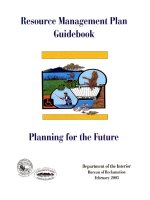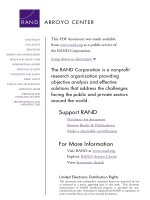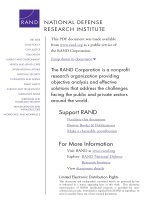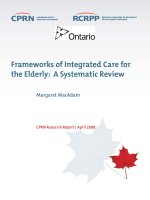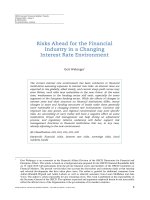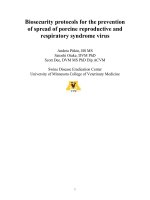Integrated Planning for the Air Force Senior Leader Workforce - Background and Methods pdf
Bạn đang xem bản rút gọn của tài liệu. Xem và tải ngay bản đầy đủ của tài liệu tại đây (510.65 KB, 81 trang )
This PDF document was made available from www.rand.org as a public
service of the RAND Corporation.
6
Jump down to document
This document and trademark(s) contained herein are protected by law as indicated in a notice
appearing later in this work. This electronic representation of RAND intellectual property is provided
for non-commercial use only. Permission is required from RAND to reproduce, or reuse in another
form, any of our research documents for commercial use.
Limited Electronic Distribution Rights
CHILD POLICY
CIVIL JUSTICE
EDUCATION
ENERGY AND ENVIRONMENT
HEALTH AND HEALTH CARE
INTERNATIONAL AFFAIRS
NATIONAL SECURITY
POPULATION AND AGING
PUBLIC SAFETY
SCIENCE AND TECHNOLOGY
SUBSTANCE ABUSE
TERRORISM AND
HOMELAND SECURITY
TRANSPORTATION AND
INFRASTRUCTURE
The RAND Corporation is a nonprofit research
organization providing objective analysis and effective
solutions that address the challenges facing the public
and private sectors around the world.
Visit RAND at www.rand.org
Explore RAND Project AIR FORCE
View document details
For More Information
Purchase this document
Browse Books & Publications
Make a charitable contribution
Support RAND
This product is part of the RAND Corporation technical report series. Reports may
include research findings on a specific topic that is limited in scope; present discus-
sions of the methodology employed in research; provide literature reviews, survey
instruments, modeling exercises, guidelines for practitioners and research profes-
sionals, and supporting documentation; or deliver preliminary findings. All RAND
reports undergo rigorous peer review to ensure that they meet high standards for re-
search quality and objectivity.
Integrated Planning for
the Air Force Senior
Leader Workforce
Background and Methods
Albert A. Robbert, Stephen M. Drezner,
John Boon, Larry Hanser, Craig Moore,
Lynn Scott, Herbert J. Shukiar
Prepared for the United States Air Force
Approved for public release; distribution unlimited
The RAND Corporation is a nonprofit research organization providing objective analysis
and effective solutions that address the challenges facing the public and private sectors
around the world. RAND’s publications do not necessarily reflect the opinions of its research
clients and sponsors.
R
®
is a registered trademark.
© Copyright 2004 RAND Corporation
All rights reserved. No part of this book may be reproduced in any form by any electronic or
mechanical means (including photocopying, recording, or information storage and retrieval)
without permission in writing from RAND.
Published 2004 by the RAND Corporation
1776 Main Street, P.O. Box 2138, Santa Monica, CA 90407-2138
1200 South Hayes Street, Arlington, VA 22202-5050
201 North Craig Street, Suite 202, Pittsburgh, PA 15213-1516
RAND URL: />To order RAND documents or to obtain additional information, contact
Distribution Services: Telephone: (310) 451-7002;
Fax: (310) 451-6915; Email:
Library of Congress Cataloging-in-Publication Data
Integrated planning for the Air Force senior leader workforce : background and methods / Albert A. Robbert
[et al.].
p. cm.
“TR-175.”
Includes bibliographical references.
ISBN 0-8330-3663-7 (pbk.)
1. Generals—Selection and appointment—United States. 2. Generals—Training of—United States. 3. United
States. Air Force—Selection and appointment. 4. United States. Air Force—Officers—Training of. I. Robbert,
Albert A., 1944–
UG793.I54 2004
358.4'1331—dc22
2004018246
The research reported here was sponsored by the United States Air Force under Contract
F49642-01-C-0003. Further information may be obtained from the Strategic Planning
Division, Directorate of Plans, Hq USAF.
iii
Preface
Organizations such as the United States Air Force, which encompass a wide
variety of operational, technical, and business-oriented activities, are complex.
And the task of ensuring the continued availability of individuals having the
competencies required to lead those activities effectively is also complex,
especially in an organization that largely selects leaders from within its own
ranks. This study, conducted in the Manpower, Personnel, and Training Program
of RAND Project AIR FORCE, examined
• Competency requirements for Air Force senior leader positions, including
both general officer (GO) and Senior Executive Service (SES) positions.
• Optimal competency mixes in the inventory of senior leaders, recognizing
that competency requirements for individual positions cannot be met
perfectly in a closed personnel system.
• Flexibility in the boundary between GO and SES utilization in order to better
meet organizational needs and enhance career development.
This work was chartered in 1998 by Gen Michael E. Ryan, then Chief of Staff of
the United States Air Force, who saw it as a way to better understand how to
develop senior personnel with both the operational knowledge and the technical
skills needed to lead the future Air Force. The research described here was
conducted within RAND Project AIR FORCE in partnership with the Air Force
General Officer Matters Office (AFGOMO) and its successor, the Air Force Senior
Leader Management Office (AFSLMO). Current and future efforts continue to
develop this body of research.
The research sponsor considers many of this study’s findings to be sensitive, so
this report generally does not present detailed findings. However, since the
methods that were developed and used in the study are likely to be of interest to
other organizations seeking to establish or enhance competency-based,
requirements-driven leadership development programs, this report describes
those methods, providing sufficient background to place them in context. The
primary audience for this report consists of human resource and line managers
interested in applying similar methods in their own organizations.
iv
RAND Project AIR FORCE
RAND Project AIR FORCE (PAF), a division of the RAND Corporation, is the
U.S. Air Force’s federally funded research and development center for studies
and analyses. PAF provides the Air Force with independent analyses of policy
alternatives affecting the development, employment, combat readiness, and
support of current and future aerospace forces. Research is performed in four
programs: Aerospace Force Development; Manpower, Personnel, and Training;
Resource Management; and Strategy and Doctrine.
Additional information about PAF is available on the RAND Web site, at
/>v
Contents
Preface iii
Figures vii
Tables ix
Summary xi
Acknowledgments xv
Acronyms xvii
1. BACKGROUND 1
2. UNDERSTANDING THE COMPETENCY REQUIREMENTS OF
USAF SENIOR LEADER JOBS 7
Defining Position Requirements 7
Developing a Job Analysis Questionnaire 8
Initial Survey Response Analyses 9
Reliability 10
Developing a Conceptual Framework 11
Deriving Primary and Secondary Skill Requirements 12
Functional Familiarities 14
Cross-Functional Competencies 14
Refresher Surveys 15
Positions Considered 16
3. MODELING CAREER PROGRESSION 17
Mathematical Underpinnings 19
Matching Faces and Spaces: The Fillmap 20
Model Constraints 22
Promotion Constraints 22
Assignment Constraints 24
The Solution Space 24
How Recent Cohorts Compare 25
Development Targets 26
4. THE GO/SES BOUNDARY 27
Differences Between GO and SES Utilization 27
Military Necessity 27
Depth and Breadth of Occupational Competencies 28
Senior Leader Grade Thresholds 29
Relaxing the Boundary 30
Benefits of a Flexible Boundary 31
5. OBJECTIVE FORCE ANALYSIS 33
Organizational Requirements for Senior Leaders 35
Theoretical Framework 35
vi
Methodology 36
Identifying Outliers 37
Career Progression Considerations 38
6. A DECISION SUPPORT SYSTEM TO FACILITATE UTILIZATION
AND DEVELOPMENT OF SENIOR LEADERS 41
Support for GO Assignment Cycles 44
7. CONCLUSIONS AND RECOMMENDATIONS 47
Multifunctionality Is Needed 47
The Tools Can Be Used to Evaluate Current and Expected
Outcomes 48
Assessing the Current Senior Leader Inventory 48
Assessing Promotion Board Results 48
Assessing Career Development Patterns 49
The Tools Can Be Used to Evaluate Demand 49
The Tools Can Be Further Enhanced 49
The Tools Have Value in Other Contexts 50
Appendix
A. JOB CHARACTERISTICS AND FACTORS IN THE GO SURVEY 53
B. FLOW MODEL SPECIFICATIONS 57
References 61
vii
Figures
1.1. Alignment of GO Grades and SES Tiers 2
1.2. An Early Conceptualization: Pyramid of GO Generalists,
Semi-specialists, and Specialists 3
3.1. Alternative Shapes of Occupational Competency Pyramids
Within the Overall GO Pyramid 18
4.1. Combinations of Functional Expertise and Position
Continuity Requirements 28
4.2. Overlapping Suitability of SES and GO Utilization in
Air Force Executive Positions 30
5.1. Flexibilities in Determining the GO and SES Integrated
Objective Force 34
5.2. Outlier Organizations 38
ix
Tables
2.1. Primary and Secondary Occupational Competencies 13
2.2. Cross-Competency Factors 15
3.1. Illustrative Match Quality Scores 20
3.2. Typical Match Quality Scores: Inventory Primary Occupational
Competency = Fighter; Inventory Secondary Occupational
Competency = Acquisition Management 21
3.3. Typical Primary/Secondary Occupational Pairings as
Development Targets 26
4.1. Sample Comparisons of Selected GO and SES Competencies 29
4.2. Filters for Determining SES-Only and GO-Only Positions 31
5.1. Match Quality Before and After Job Additions, Deletions, and
Migrations 39
A.1. GO Job Characteristics and Their Factor Loadings 54
xi
Summary
As Chief of Staff of the Air Force in 1998, Gen Michael E. Ryan observed a
mismatch between the qualifications of Air Force general officers (GOs) and
some of the jobs they needed to fill. Finding too few candidates with
backgrounds appropriate for filling senior warfighting positions and many GOs
with backgrounds too specialized to be very useful at higher grades, he asked
RAND Project AIR FORCE (PAF), a division of the RAND Corporation, to help
improve the Air Force’s GO development approach. Through an initial position-
level analysis, PAF found that selectivity could be increased and utilization
improved if GOs, including those who came from operational backgrounds, had
broader experience. Based on these findings, the senior leadership of the Air
Force chartered PAF and the Air Force General Officer Matters Office
(AFGOMO) to undertake a more detailed study. As this study unfolded, PAF
and its Air Force sponsors recognized that a significant part of the Air Force
senior leadership need is supplied by members of the Senior Executive Service
(SES). Accordingly, the study was expanded to include that segment of the senior
leader force.
1
To execute this study, PAF and the Air Force
• Identified required competencies for each GO and SES position. (See pages
7–16.)
• Identified the ideal mix of competencies among annual cohorts promoted
into the GO and SES ranks using a model of the flow of individuals through
GO grades and career progression tiers within the SES. (See pages 17–26.)
• Constructed templates to guide the development of competitive middle-
grade officers and civil servants based on the competency distributions
within these entry cohorts. (See page 26.)
• Examined the boundary between GO and SES utilization to find new
flexibilities in meeting senior leader needs. (See pages 27–32.)
________________
1
As an eventual consequence of this decision, the Air Force Senior Executive Matters Office
(AFSEMO), which managed the SES workforce, merged with AFGOMO in 2002 to form the Air Force
Senior Leader Management Office (AFSLMO).
xii
• Employed the flow model and other, related analyses to help the Air Force
improve the identification and GO/SES mix of the set of senior leader
positions it intends to fill (referred to as the objective force). (See pages 33–39.)
• Constructed a decision support system (DSS) prototype to help the Air Force
employ competency information in GO assignment actions. (See pages
41–45.)
As PAF worked through these steps, a framework for organizing competency
requirements emerged. Most jobs were found to have a primary occupational
competency: prior experience gained in a specific operational/functional area
(e.g., fighter pilot) or a “bin” containing a number of such areas that is critical to
success in the position. Many positions also required a secondary occupational
competency: prior experience in a second operational/functional area or bin.
Primary and secondary occupational competencies can be considered “provider-
level” skills—that is, the individual is expected to be able to manage the
provision of services generated in the function. Additionally, all jobs require
multiple areas of functional familiarity, which is defined as the ability to be an
informed consumer of services generated by other functions. Finally, all jobs
require an array of cross-functional competencies: leadership skills, management
skills, and other competencies that are common across positions in many
operational/functional areas.
Methods employed in the study included
• Surveys of incumbents, initially using paper-and-pencil instruments, and
later using Web-based or email-based electronic versions. (See pages 8–9.)
• Review and synthesis of survey results by PAF and relatively senior
(lieutenant general or SES equivalent) panels of knowledgeable Air Force
representatives. (See pages 9–10.)
• Linear programming modeling to optimize objective force configurations
(see pages 38–39) and the flow of individuals through positions. (See pages
18–24.)
• Construction and application of rules to determine military or civilian
essentiality of senior leader positions. (See pages 30–31.)
• Statistical regression analysis to quantify the relative needs for senior leaders
within Air Force organizations. (See pages 35–38.)
• Systematic software development practices to construct a prototype DSS.
(See pages 41–45.)
xiii
The study’s major findings are as follows:
• Most positions require a secondary competency, giving rise to the need for
simultaneous multifunctionality: the incumbent needs both primary and
secondary competencies to enhance his/her success in a given position. (See
page 17.)
• Within the set of jobs sharing a common primary occupational competency,
grade requirements often do not form a neat career progression pyramid:
with expected promotion patterns, individuals cannot progress from grade
to grade (GO) or tier to tier (SES) within the same primary occupational
competency. Accordingly, individuals must shift among primary
occupational pyramids as they rise through the grades or tiers, giving rise to
the need for serial multifunctionality. (See pages 17–19.)
• Recent cohorts of individuals selected for promotion to brigadier general
approximately matched the ideal distribution of primary occupational
competencies but exhibited the required multifunctionality to only a very
limited degree. To provide the needed competencies in the future, deliberate
efforts must be made to broaden competitive middle-grade officers. (See
pages 25–26.)
• While most positions have characteristics that make them suitable only for
GO incumbents in some cases and SES incumbents in others, a sizable
minority of positions can be filled “flexibly,” in other words, by either GO or
SES incumbents. (See pages 30–31.)
• Using these flexibilities in the GO/SES boundary, career progression can be
enhanced in both the GO and SES segments of the senior leader force. (See
pages 31–32.)
• A DSS can help to more systematically manage the assignments of GOs. (See
pages 44–45.)
xv
Acknowledgments
Our work could not have succeeded without the explicit support of two
successive Chiefs of Staff of the Air Force—Gen Michael E. Ryan and Gen John
Jumper—and the concurrence of the top echelons of the Air Force’s general
officers and Senior Executive Service members. Our thinking was shaped
significantly through discussions with Gen Billy Boles (USAF, retired) and the
late Gen Robert Dixon (USAF, retired). Mr. Roger Blanchard, Assistant Deputy
Chief of Staff for Personnel, was instrumental in helping us shape our analysis
regarding the Senior Executive Service. Brig Gen Rich Hassan, Director of the Air
Force Senior Leader Management Office, provided steadfast direction and
support, with able assistance from Lt Cols Cheryl Daly and Cassie Barlow, Majs
Brian Kelly and Tony Novello, Capt Gwen Rutherford, Mr. John Service, and Ms.
Katrina Jones. Our RAND colleagues who made important contributions to the
project included Louis Miller, Richard Stanton, Ray Conley, Wendy Richman
Hirsch, Mike Thirtle, Brent Thomas, Jody Paul, Rafal Szczyrba, and Mitch Tuller.
Meg Harrell and Mike Hix provided thoughtful reviews.
xvii
Acronyms
AFGOMO Air Force General Officer Matters Office
AFSEMO Air Force Senior Executive Matters Office
AFSLMO Air Force Senior Leader Management Office
C2ISR command, control, intelligence, surveillance, and reconnaissance
CMDB Command Manpower Database
DSS decision support system
ERB Executive Resources Board
FY fiscal year
GO general officer
IG inspector general
KSAO knowledge, skills, abilities, and other characteristics
LTO long-term objective
OPM (U.S.) Office of Personnel Management
PAF Project AIR FORCE
SAPA Succession Analysis and Planning Assistant
SES Senior Executive Service
1
1. Background
Soon after becoming Chief of Staff of the Air Force in 1998, Gen Michael E. Ryan
observed a mismatch between the qualifications of Air Force general officers
(GOs) and some of the jobs they needed to fill. He found too few candidates with
backgrounds appropriate for filling senior warfighting positions.
1
He also saw
many GOs with backgrounds too specialized to be very useful for future
positions at higher grades. He asked RAND Project Air Force (PAF), a division of
the RAND Corporation, to study the problem and recommend ways of
improving the match between future GOs’ qualifications and the jobs they must
fill.
The structure that was the focus of General Ryan’s concern includes
approximately 255 line GOs arrayed in four grades: brigadier general (O-7),
major general (O-8), lieutenant general (O-9), and general (O-10).
2
Since there are
usually more than 255 GO jobs to fill, some jobs must be filled with colonels (O-
6s) who have already been selected for promotion to brigadier general. Each
officer is assigned to one of approximately 180 Air Force or 80 joint positions
(from among a much larger number of joint positions that are filled at different
times by flag officers from different military services). GO positions are not
aligned with specific Air Force specialties, but many of them have been filled
historically by officers with specific career backgrounds (e.g., fighter pilots, civil
engineers, acquisition managers).
In addition to relying on the GO force to meet its senior leadership needs, the Air
Force relies on approximately 160 career members of the Senior Executive Service
(SES).
3
The SES consists of a single pay grade with six pay rates, or steps. Federal
agencies are allowed great flexibility in determining pay rates for individual SES
members, so SES pay rates do not inherently correlate with the responsibility and
authority of an incumbent’s job, as is the case with GO grades and jobs.
Additionally, there is no natural patterning of career paths, as is afforded by the
________________
1
The goal stated then and adopted in our analyses was that there be at least three qualified
candidates eligible for consideration whenever a vacancy had to be filled. In subsequent chapters, we
refer to the ratio of jobs to be filled to qualified candidates as assignment selectivity.
2
Line is understood in this context to exclude officers in the medical, chaplain, and judge
advocate general promotion categories.
3
This count also includes the relatively small number of members of the Senior Intelligence
Executive Service working within the Department of the Air Force. Throughout the text, when we
use the term SES, we intend that it also include the Senior Intelligence Executive Service.
2
GO grade structure. Recognizing a need for such patterning, the Air Force has
aligned its SES jobs into a four-tier structure based on scope of responsibility and
roughly comparable to the GO grade structure.
4
The resulting pyramids define
patterns of job progression that enhance development of needed senior leader
competencies. Additionally, pay rates and potential bonus levels are linked to job
tier. This alignment provides financial incentives for senior executives to accept
the organizational and geographical mobility required to progress through the
pyramids. Figure 1.1 illustrates how GO grades and SES tiers are aligned in a job
progression pyramid.
5
To illustrate his concern, General Ryan sketched the diagram shown as Figure 1.2
and asked whether the Air Force was creating an appropriate mix of generalists,
semi-specialists, and specialists in its GO force. He used the term generalists to refer
to individuals with experience in the core functions of the Air Force, primarily
aircraft operations. Individuals with these backgrounds are generally considered
most suitable for filling the most senior GO positions. Semi-specialists is the term
for line managers with experience in functions such as space, logistics, civil
RAND TR175-1.1
O-10
O-7
O-8
O-9 Tier 1
Tier 4
Tier 3
Tier 2
Figure 1.1—Alignment of GO Grades and SES Tiers
_________________
4
To our knowledge, no other federal agency has aligned its SES force in this manner.
5
The absence of a tier corresponding to grade O-10 does not mean that civilians do not occupy
comparable positions. However, all civilian positions at this level are filled by political appointees
rather than career members of the SES.
3
RAND TR175-1.2
O-10
O-7
O-8
O-9
Generalist
Specialist
Semi-specialist
Figure 1.2—An Early Conceptualization: Pyramid of GO Generalists,
Semi-specialists, and Specialists
engineering, personnel management, and financial management, which are less
central to Air Force missions. Individuals with these backgrounds generally fill
positions corresponding to their functional qualifications, which are typically at
grades O-9 and below. Specialists was what he called individuals in the
traditional professions (legal, medical, and chaplain), for which the relevant
positions are at grade O-8 and below. He saw the need for more generalists and
fewer semi-specialists in the GO corps, and for semi-specialists with greater
operational awareness.
In an initial analysis, and working together closely, the Air Force General Officer
Matters Office (AFGOMO)
6
and PAF developed a database that delineated
numerous areas of knowledge, specific skills, experiences, and innate abilities
considered important for each position that an Air Force GO could fill. These
included GO positions within the Air Force, of course, as well as joint positions
that the Air Force shares with the other services. Statistical analysis
7
of the data
sorted the positions into groups that required similar backgrounds. After
categorizing each current and anticipated future job as requiring either a
________________
6
In 2001, AFGOMO merged with the Senior Executive Matters Office (AFSEMO), which
managed the civilian force of senior executives, whose grades were roughly equivalent to GOs, to
become the Air Force Senior Leader Management Office (AFSLMO).
7
Cluster analysis organized the positions into groups requiring similar combinations of
knowledge, skills, and abilities.
4
generalist, a semi-specialist, or a specialist, we calculated for each category and
grade a measure of promotion selectivity: the ratio between (a) the number of
GOs eligible for promotion to the grade and (b) the number of promotions into
the grade needed per year (to replace those retiring or promoted to the next
higher grade). We found notably lower promotion selectivity in the generalist
category, both at the time of the analysis and for the future, especially at the
higher GO grades.
While that analysis was relatively coarse, we were able to draw several key
conclusions from it:
• Selectivity would be increased if GOs had broader backgrounds and thus
could serve effectively in a wider range of positions.
• Many GOs needed greater appreciation of Air Force and joint combat and
support operations in order to serve effectively in an environment becoming
increasingly expeditionary and joint.
• Categorization of GO positions and officers as generalists, semi-specialists,
and specialists served a useful interim purpose, but it was inadequate both
for expressing goals for the development of future GOs and for analyzing the
flows and allocations of officers within the GO force.
8
Upon reviewing these conclusions in 1999, senior Air Force leadership asked
PAF to develop a more detailed framework for describing the backgrounds
required in various GO positions. Simultaneously, the leadership created a new
staff activity to work toward developing future generations of senior leaders
whose backgrounds would allow greater selectivity and would align better with
their jobs’ competency requirements.
9
In response, PAF sought to address the following problems and issues:
• To reach a better understanding of the background requirements of GO
positions, there would have to be a comprehensive competency framework.
Within this framework, the requirements for each position would have to be
determined with a reasonable level of fidelity and reliability.
_________________
8
Our research revealed that many of the Air Force’s most senior and critical positions would be
best characterized as requiring not general, nonspecific backgrounds but, rather, multiple specific
operational or functional competencies.
9
The new staff activity was organized during most of 2001 and 2002 as the Developing
Aerospace Leaders Program Office. It was later incorporated as a division within AFSLMO and then,
more recently, transferred to the Directorate of Strategic Plans and Future Systems (AF/DPX).
5
• In a closed personnel system, all positions are filled by the cohorts of
individuals who pass through entry-level selection processes. For GO
positions, these cohorts consist of the relatively small number of colonels
selected each year for promotion to brigadier general. To minimize learning
on the job, these cohorts should come as close as possible to supplying all the
competencies needed in all GO positions. Accordingly, an optimal and
feasible distribution of competencies in these cohorts is needed as a template
for developing pools of highly qualified candidates.
• A significant part of the Air Force’s need for senior leadership is met by
members of the Senior Executive Service (SES). Career members of the SES
occupy jobs that are comparable to those filled by military officers in grades
from colonel to lieutenant general.
10
While these SES members do not
formally command military units, they may serve as directors or deputy
directors of non-warfighting organizations and staff elements, as well as in a
variety of specialized staff positions. Many have prepared for their positions
through lengthy careers within the Department of the Air Force. To fully
address Air Force senior leader needs, leader development and selectivity
had to be looked at not only within the GO force, but within the Air Force’s
senior civil service workforce as well.
• In the past, GO and SES positions were considered relatively fixed. However,
some flexibility in the choice of whether to use GO or SES members to fill
specific positions might enhance the management of both the GO and the
SES workforces.
• The Air Force is limited in the number of GOs and SES members it may have
on its rolls. It must allocate these scarce resources to specific organizations
and activities so as to meet the current leadership needs while also providing
opportunities to further develop individuals for the highest GO and SES
levels. An understanding of GO and SES career progression needs could
inform this resource allocation process.
• Determining GO and SES competency requirements for the purpose of
developing future leaders with those competencies yields a rich database
that, if married to information on the competencies of current GOs and SES
members, could be used to help manage the ongoing utilization and further
development of these resources.
This report describes the analytic steps taken by PAF to address these issues.
Chapter Two describes how the database of competencies required for the GO
________________
10
For protocol purposes, all SES members are considered equivalent to general officers—i.e.,
they are all considered to be at Distinguished Visitor Code 6 or higher.



